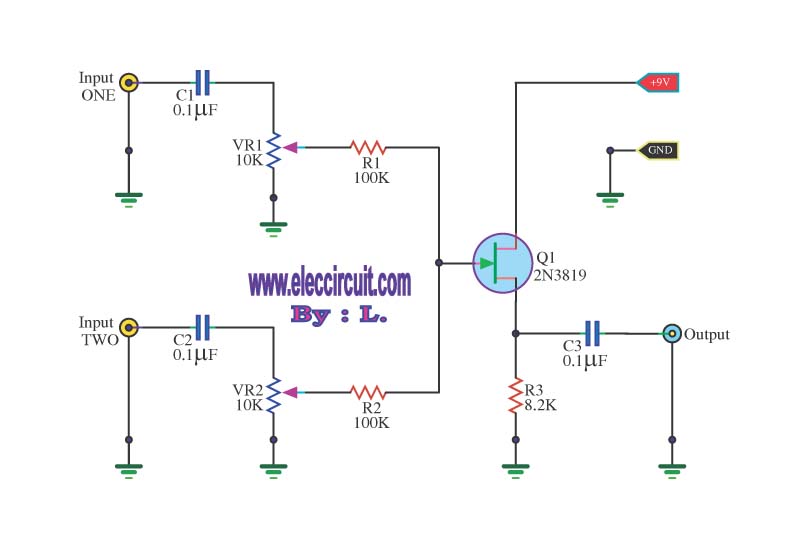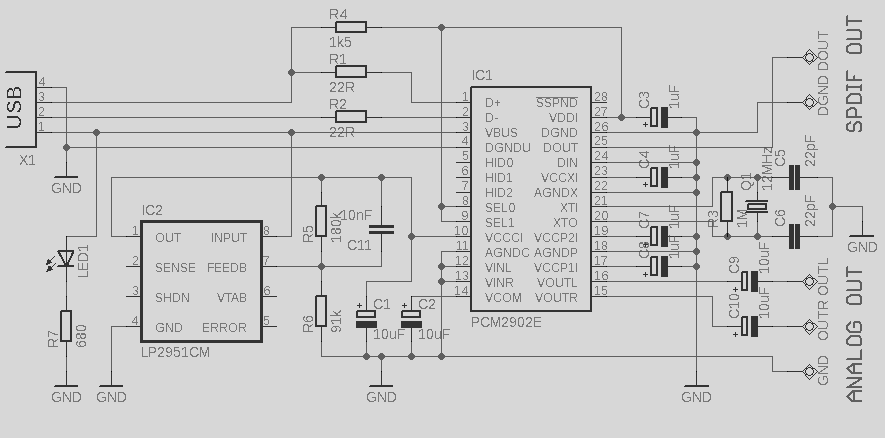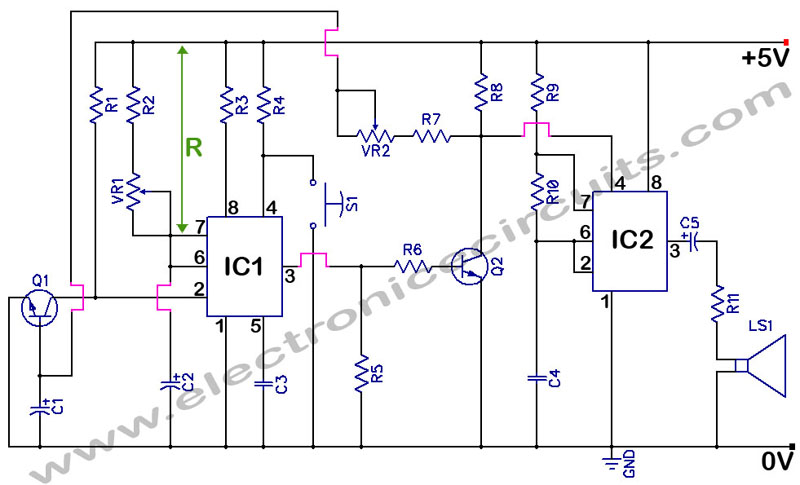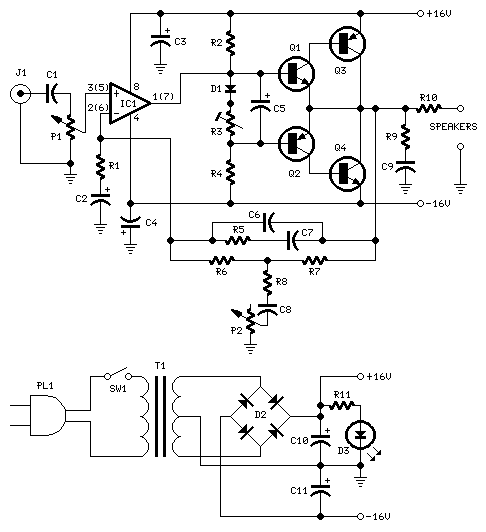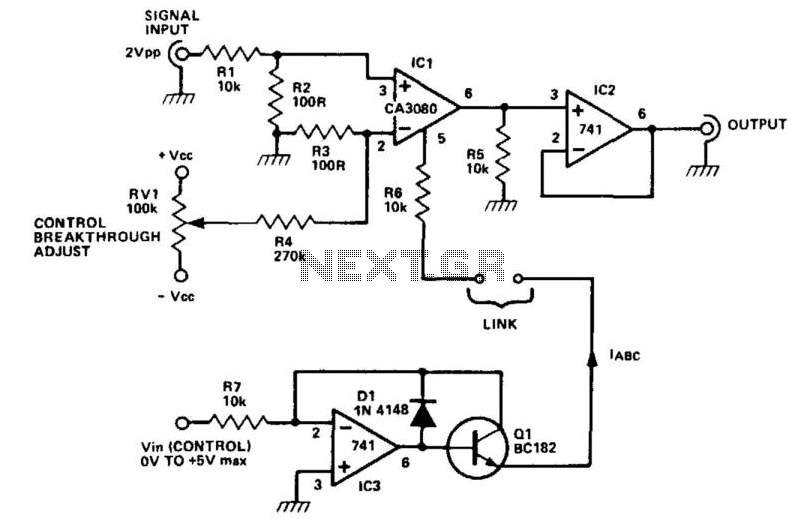
Simple Hybrid Audio Amplifier
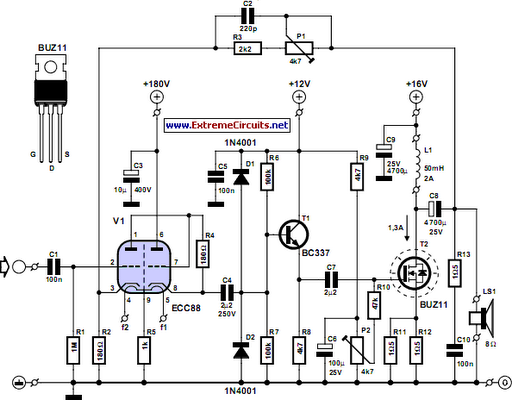
The ongoing debate regarding the superiority of valves versus transistors is not the focus here. However, for those uncertain about their choice, this simple amplifier serves as an excellent experiment. The design employs a valve as a pre-amplifier and a MOSFET in the output stage. Strong negative feedback ensures a frequency response that is exceptionally flat. The prototype has been tested with alternative components, such as substituting the BUZ11 with an IRFZ34N and the ECC88 with an ECC83. In this case, the anode voltage should be slightly reduced to 155 V. The ECC83 (or its US equivalent, the 12AX7) requires a filament supply of 2 x 6.3 V, with no screen between the two triodes, which is typically connected to pin 9. In this design, pin 9 is connected to the common of the two filaments, which are grounded via R5. For optimal quality, MKT types should be used for coupling capacitors C1, C4, and C7, with MKP capacitors being preferable. For C8, Panasonic's audio-grade electrolytics are recommended. P1 adjusts the negative feedback amount; greater negative feedback results in a flatter frequency response but reduces overall gain. P2 sets the quiescent current through T2, which is set to a relatively high 1.3 A, allowing the output stage to operate in Class A mode, generating significant heat, necessitating a large heatsink for T2 with a thermal coefficient of 1 K/W or better. L1 is formed by connecting two secondary windings in series from a 2x18V/225 VA toroidal transformer, resulting in an inductance of 150 mH, exceeding the recommended 50 mH. However, the amplifier struggles to reproduce signals below 160 Hz, with distortion reaching 9% at 20 Hz for a 100 mW signal. To effectively reproduce low-frequency signals, a larger inductor with an iron core and air gap is required to prevent core saturation under large DC currents, which can be sourced from obsolete equipment like old video recorders. The core should consist of welded E and I sections, which can be converted to the necessary inductor by removing the windings, adding 250 to 300 turns of 0.8 mm enamelled copper wire, and reassembling the sections with paper for insulation. The circuit's concepts allow for experimentation, though managing multiple supply voltages can be challenging. A specifically designed power supply for this amplifier (Quad power supply for hybrid amp) is available, which can also be used with other amplifiers. This supply utilizes a cascade stage to provide an unstabilized voltage of 170 V for the SRPP (single rail push-pull) stage (V1). Initial measurements indicated that ripple from this supply caused significant hum at the amplifier's output. To address this, a separate high-voltage regulator with short circuit protection was designed to handle these high voltages. If a separate transformer is used for the filament supply, testing without R5 is advisable. During testing with a DC voltage for the filament supply, the amplifier performed surprisingly well, often outperforming many consumer amplifiers. Although the output power is limited, it remains sufficient for enjoyable listening. For increased power, using multiple MOSFETs in the output stage and a more robust inductor is recommended. Given that this is a Class A amplifier, the power supply must be capable of delivering the necessary current, which increases significantly at higher output levels. The amplifier's efficiency is slightly above 30%.
This amplifier circuit is characterized by its unique hybrid design, combining the warmth of valve amplification with the efficiency of solid-state components. The ECC83 valve serves as the pre-amplifier, providing a rich harmonic content to the audio signal, while the MOSFET output stage ensures a robust performance with high current handling capabilities. The use of strong negative feedback not only enhances linearity but also minimizes distortion across the audio spectrum, making it suitable for high-fidelity applications.
The choice of components is critical in achieving the desired performance. The coupling capacitors (C1, C4, C7) should be of high quality to maintain signal integrity. MKT capacitors are adequate, but MKP types are preferred for their lower equivalent series resistance (ESR) and improved frequency response. The output stage's quiescent current, set by P2, is vital for Class A operation, ensuring that the MOSFET remains in its linear region, providing a smooth and distortion-free output.
The inductor L1 plays a significant role in the amplifier's low-frequency response. The original design's inductance of 150 mH, while higher than recommended, limits the amplifier's ability to reproduce bass frequencies effectively. A larger inductor with an iron core and air gap is essential for improved performance in the lower frequency range. The construction of such an inductor from E and I sections allows for a customized solution tailored to the amplifier's needs.
The power supply design is equally important, as it must deliver stable voltages while minimizing ripple to prevent hum. The cascade stage provides the necessary high voltage, while the dedicated voltage regulator ensures that fluctuations do not impact audio performance. The option to experiment with separate transformers for the filament supply allows for further optimization of the amplifier's performance.
Overall, this amplifier design exemplifies the fusion of traditional valve technology with modern solid-state components, offering a platform for audio experimentation and enhancement while delivering quality sound reproduction.The debate still goes on as to which are better, valves or transistors. We don`t intend to get involved in that argument here. But if you can`t make your mind up, you should try out this simple amplifier. This amplifier uses a valve as a pre-amplifier and a MOSFET in the output stage. The strong negative feedback makes the frequency response as fl at as a pancake. In the prototype of the amplifier we`ve also tried a few alternative components. For example, the BUZ11 can be replaced by an IRFZ34N and an ECC83 can be used instead of the ECC88. In that case the anode voltage should be reduced slightly to 155 V. The ECC83 (or its US equivalent the 12AX7) requires 2 x 6. 3 V for the filament supply and there is no screen between the two triodes, normally connected to pin 9. This pin is now connected to the common of the two filaments. The filaments are connected to ground via R5. If you`re keeping an eye on the quality, you should at least use MKT types for coupling capacitors C1, C4 and C7.
Better still are MKP capacitors. For C8 you should have a look at Panasonic`s range of audio grade electrolytics. P1 is used to set the amount of negative feedback. The larger the negative feedback is, the flatter the frequency response will be, but the smaller the overall gain becomes. With P2 you can set the quiescent current through T2. We have chosen a fairly high current of 1. 3 A, making the output stage work in Class A mode. This does generate a relatively large amount of heat, so you should use a large heatsink for T2 with a thermal coefficient of 1 K/W or better.
For L1 we connected two secondary windings in series from a 2x18V/225 VA toroidal transformer. The resulting inductance of 150 mH was quite a bit more than the recommended 50 mH. However, with an output power of 1 W the amplifier had difficulty reproducing signals below 160 Hz. The distortion rose to as much as 9% for a signal of 20 Hz at 100 mW. To properly reproduce low-frequency signals the amplifier needs a much larger coil with an iron core and an air gap. This prevents the core from saturating when a large DC current flows through the coil. Such a core may be found in obsolete equipment, such as old video recorders. A suitable core consists of welded E and I sections. These transformers can be converted to the required inductor as follows: cut through the welding, remove the windings, add 250 to 300 windings of 0.
8 mm enamelled copper wire, firmly fix the E and I sections back together with a piece of paper in between as isolation. The concepts used in this circuit lend themselves very well to some experimentation. The number of supply voltages can be a bit of a problem to start with. For this reason we have designed a power supply especially for use with this amplifier (Quad power supply for hybrid amp).
This can of course just as easily be used with other amplifiers. The supply uses a cascade stage to output an unstabilised voltage of 170 V for the SRPP (single rail push pull) stage (V1). During initial measurements we found that the ripple on this supply was responsible for a severe hum at the output of the amplifier.
To get round this problem we designed a separate voltage regulator (High-voltage regulator with short circuit protection), which can cope with these high voltages. If you use a separate transformer for the filament supply you can try and see if the circuit works without R5.
During the testing we used a DC voltage for the filament supply. Although you may not suspect it from the test measurements (see table), this amplifier doesn`t sound bad. In fact, it is easily better than many consumer amplifiers. The output power is fairly limited, but is still enough to let your neighbours enjoy the music as well.
It is possible to make the amplifier more powerful, in which case we recommend that you use more than one MOSFET in the output stage. The inductor also needs to be made beefier. Since this is a Class A amplifier, the supply needs to be able to output the required current, which becomes much greater at higher output powers.
The efficiency of the amplifier is a bit over 30%. 🔗 External reference
This amplifier circuit is characterized by its unique hybrid design, combining the warmth of valve amplification with the efficiency of solid-state components. The ECC83 valve serves as the pre-amplifier, providing a rich harmonic content to the audio signal, while the MOSFET output stage ensures a robust performance with high current handling capabilities. The use of strong negative feedback not only enhances linearity but also minimizes distortion across the audio spectrum, making it suitable for high-fidelity applications.
The choice of components is critical in achieving the desired performance. The coupling capacitors (C1, C4, C7) should be of high quality to maintain signal integrity. MKT capacitors are adequate, but MKP types are preferred for their lower equivalent series resistance (ESR) and improved frequency response. The output stage's quiescent current, set by P2, is vital for Class A operation, ensuring that the MOSFET remains in its linear region, providing a smooth and distortion-free output.
The inductor L1 plays a significant role in the amplifier's low-frequency response. The original design's inductance of 150 mH, while higher than recommended, limits the amplifier's ability to reproduce bass frequencies effectively. A larger inductor with an iron core and air gap is essential for improved performance in the lower frequency range. The construction of such an inductor from E and I sections allows for a customized solution tailored to the amplifier's needs.
The power supply design is equally important, as it must deliver stable voltages while minimizing ripple to prevent hum. The cascade stage provides the necessary high voltage, while the dedicated voltage regulator ensures that fluctuations do not impact audio performance. The option to experiment with separate transformers for the filament supply allows for further optimization of the amplifier's performance.
Overall, this amplifier design exemplifies the fusion of traditional valve technology with modern solid-state components, offering a platform for audio experimentation and enhancement while delivering quality sound reproduction.The debate still goes on as to which are better, valves or transistors. We don`t intend to get involved in that argument here. But if you can`t make your mind up, you should try out this simple amplifier. This amplifier uses a valve as a pre-amplifier and a MOSFET in the output stage. The strong negative feedback makes the frequency response as fl at as a pancake. In the prototype of the amplifier we`ve also tried a few alternative components. For example, the BUZ11 can be replaced by an IRFZ34N and an ECC83 can be used instead of the ECC88. In that case the anode voltage should be reduced slightly to 155 V. The ECC83 (or its US equivalent the 12AX7) requires 2 x 6. 3 V for the filament supply and there is no screen between the two triodes, normally connected to pin 9. This pin is now connected to the common of the two filaments. The filaments are connected to ground via R5. If you`re keeping an eye on the quality, you should at least use MKT types for coupling capacitors C1, C4 and C7.
Better still are MKP capacitors. For C8 you should have a look at Panasonic`s range of audio grade electrolytics. P1 is used to set the amount of negative feedback. The larger the negative feedback is, the flatter the frequency response will be, but the smaller the overall gain becomes. With P2 you can set the quiescent current through T2. We have chosen a fairly high current of 1. 3 A, making the output stage work in Class A mode. This does generate a relatively large amount of heat, so you should use a large heatsink for T2 with a thermal coefficient of 1 K/W or better.
For L1 we connected two secondary windings in series from a 2x18V/225 VA toroidal transformer. The resulting inductance of 150 mH was quite a bit more than the recommended 50 mH. However, with an output power of 1 W the amplifier had difficulty reproducing signals below 160 Hz. The distortion rose to as much as 9% for a signal of 20 Hz at 100 mW. To properly reproduce low-frequency signals the amplifier needs a much larger coil with an iron core and an air gap. This prevents the core from saturating when a large DC current flows through the coil. Such a core may be found in obsolete equipment, such as old video recorders. A suitable core consists of welded E and I sections. These transformers can be converted to the required inductor as follows: cut through the welding, remove the windings, add 250 to 300 windings of 0.
8 mm enamelled copper wire, firmly fix the E and I sections back together with a piece of paper in between as isolation. The concepts used in this circuit lend themselves very well to some experimentation. The number of supply voltages can be a bit of a problem to start with. For this reason we have designed a power supply especially for use with this amplifier (Quad power supply for hybrid amp).
This can of course just as easily be used with other amplifiers. The supply uses a cascade stage to output an unstabilised voltage of 170 V for the SRPP (single rail push pull) stage (V1). During initial measurements we found that the ripple on this supply was responsible for a severe hum at the output of the amplifier.
To get round this problem we designed a separate voltage regulator (High-voltage regulator with short circuit protection), which can cope with these high voltages. If you use a separate transformer for the filament supply you can try and see if the circuit works without R5.
During the testing we used a DC voltage for the filament supply. Although you may not suspect it from the test measurements (see table), this amplifier doesn`t sound bad. In fact, it is easily better than many consumer amplifiers. The output power is fairly limited, but is still enough to let your neighbours enjoy the music as well.
It is possible to make the amplifier more powerful, in which case we recommend that you use more than one MOSFET in the output stage. The inductor also needs to be made beefier. Since this is a Class A amplifier, the supply needs to be able to output the required current, which becomes much greater at higher output powers.
The efficiency of the amplifier is a bit over 30%. 🔗 External reference
